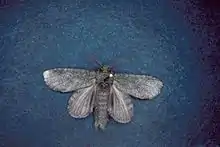Heterocampa guttivitta
Heterocampa guttivitta, the saddled prominent moth, is a species of moth of the family Notodontidae. It is found in North America, including Alabama, Arkansas, Connecticut, Delaware, Florida, Georgia, Illinois, Indiana, Iowa, Kansas, Kentucky, Maine, Maryland, Massachusetts, Minnesota, New Brunswick, New Hampshire, New Jersey, New York, North Carolina, Ohio, Oklahoma, Ontario, Pennsylvania, South Carolina, Tennessee, Vermont, Virginia, West Virginia and Wisconsin.[2]
| Saddled prominent moth | |
|---|---|
 | |
| Scientific classification | |
| Kingdom: | |
| Phylum: | |
| Subphylum: | |
| Class: | |
| Order: | |
| Family: | |
| Genus: | |
| Species: | H. guttivitta |
| Binomial name | |
| Heterocampa guttivitta | |
| Synonyms | |
| |
The wingspan is about 40 mm. Adults are brownish to greenish grey with white or black spots on the forewings. There is one generation per year.
The larvae feed on the foliage of a wide range of woody plants, including apple, birch, blueberry, dogwood, hazel, maple, oak, sumac and walnut.[3] The first two instars cling to silken feeding mats on the underside of the leaf. They skeletonize the leaf leaving only a few major veins. Later instars feed on the outside of the leaf consuming all the tissue except major veins. The species overwinters in the pupal stage in a cocoon buried in leaf litter on the ground.[4]
Gallery
 Larva
Larva Larva
Larva